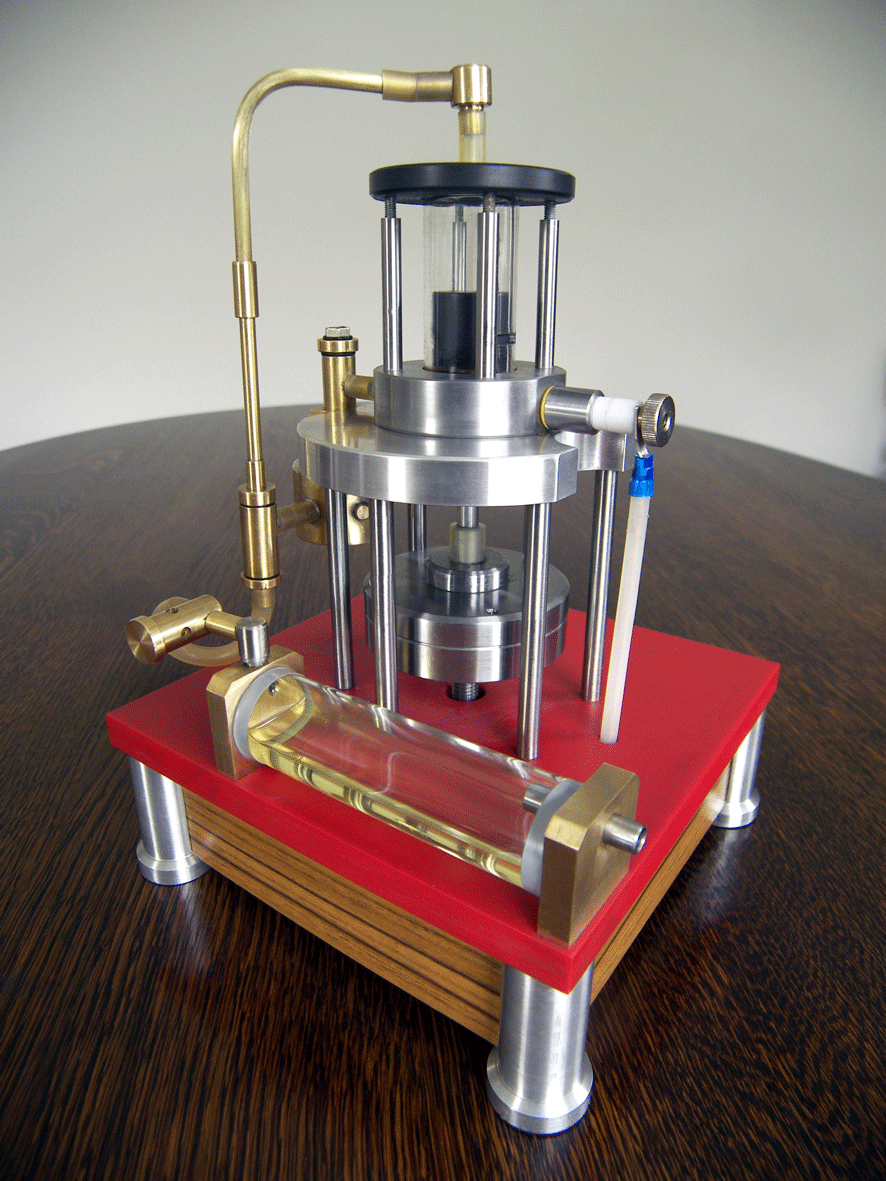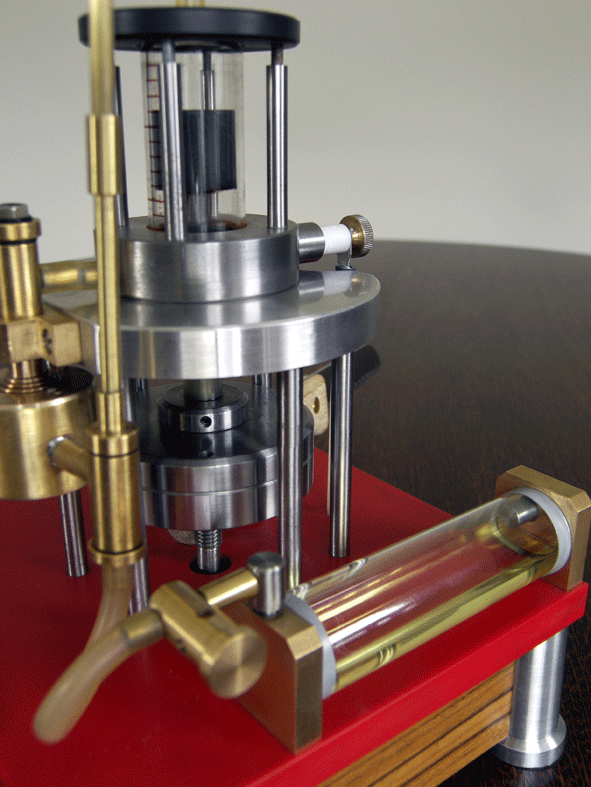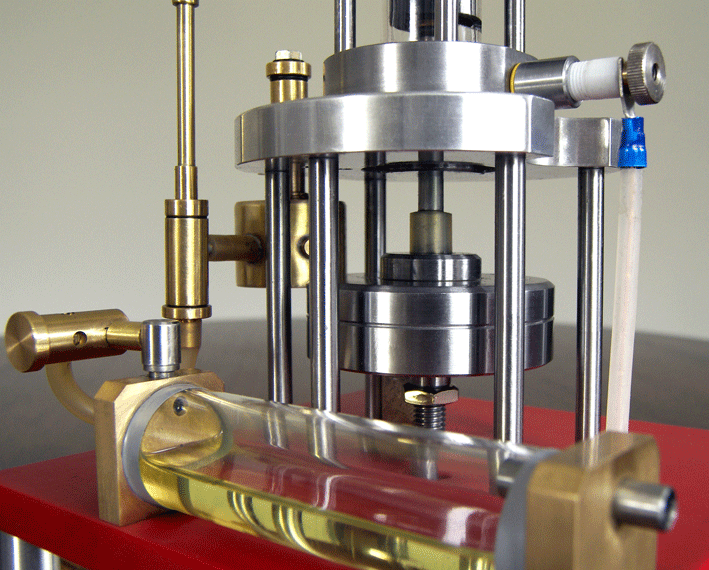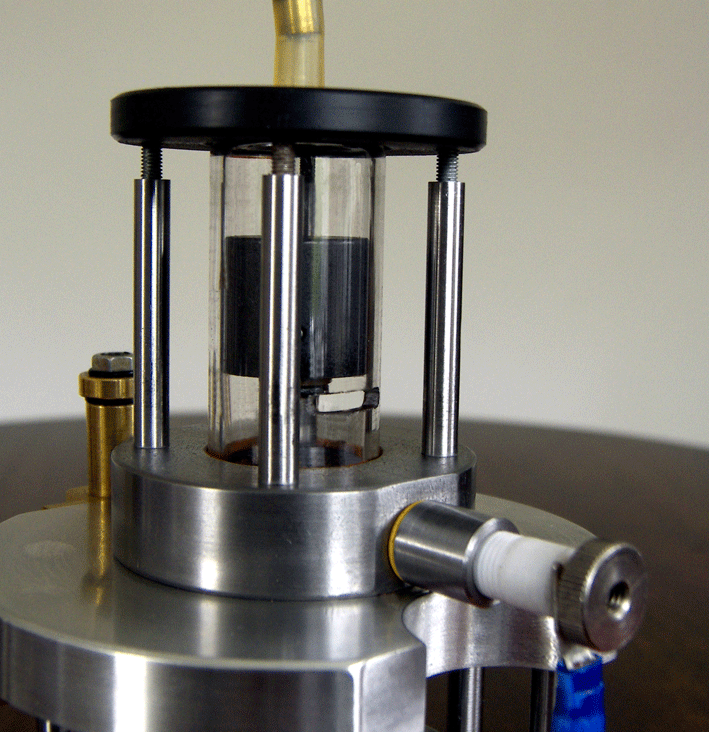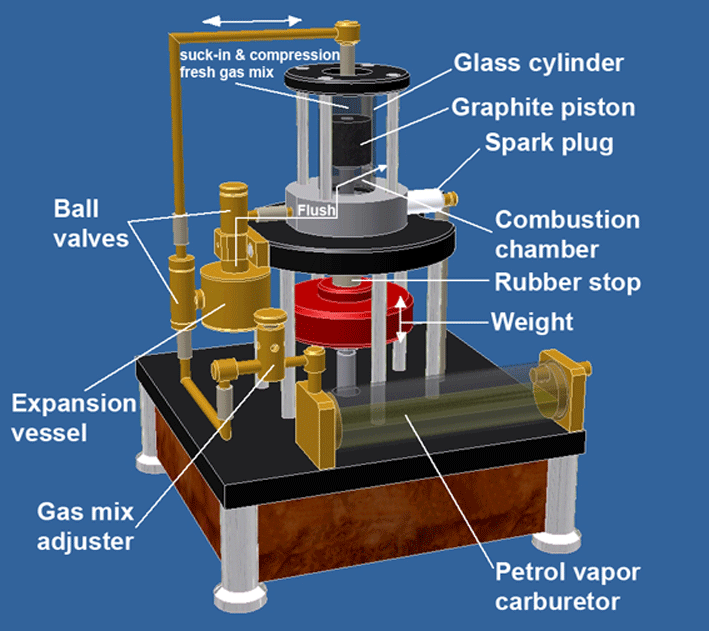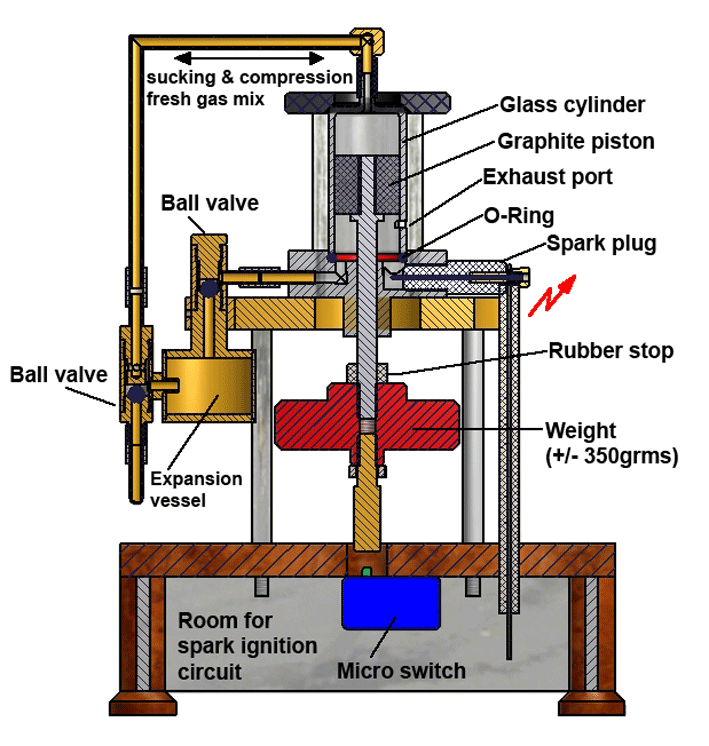Introduction
If you don't know what you now have to make again, there are several options: sit still, killing the time with a completely different hobby or design and make a crazy 2-stroke engine full of risks. I chose the latter because I happen to like playing with basic physics and shape it into a working model.
I imagined that it would be funny to make a combustion engine in which the compression is made purely by gravity force, so without flywheel and crankshaft. A weight on the piston axis must compress the the fresh gas mix below the piston and the 4.5 x greater combustion pressure must push the piston upwards again beyond the exhaust hole in the cylinder. With a pipe system with two one-way ball valves and an expansion vessel between the top and the bottom of the cylinder the fresh gas mix is sucked-in from the carburettor and compressed also, so that at the right moment the fresh gas mix flushes the burnt gasses out of the cylinder so the process will repeat itself; actually the well known 2-stroke process.
I realized that there are at least three "bears on the road" making the project extremely risky and chasing them away was actually my main challenge. Even if the engine would actually do what I had in mind it will not have any practical significance, but that goes for all my model engines. Some will understand my intent, others will probably raise their eyebrows at this strange project. It's like a joke: it is laughing or compassionately shaking with one's head.
The design
The CAD pictures below illustrate the design:
The compression pressure is created below the piston when it is pulled downwards by the weight and at the moment the bottom of it closes the exhaust port in the cylinder. This compression is determined by the mass of the weight, but also by the kinetic energy (1/2mv2) of the weight.
The spark must occur at maximum compression pressure, controlled by a switch that is pressed at the moment when the piston reaches its lowermost position. The approximate 4.5x higher combustion pressure pushes the piston back upwards again to well beyond the exhaust port in the cylinder. At the moment the piston opens the exhaust port the cylinder will be flushed with the compressed fresh gas mix. Above the piston the process of sucking-in the fresh gas mix from the carburettor takes place and also the compression of it.
The process is completely pressure controlled by two automatic ball valves as I did earlier with the "Pressure controlled 2-stroke Sabine", see the concerning page. The animation on that page demonstrates how this works, but the connections of the ball valve system on the cylinder are reversed here because the combustion chamber is below the piston is instead of above. The expansion vessel in this system ensures that the compression pressure of the fresh gas mixture is not too high to avoid slowing down the upward movement of the piston.
The"bears on the road"
As said I foresaw at least three "bears" who could obstruct the road to success:
Bear # 1: The compression and the piston stroke.
There is a certain minimal compression required for a reliably gas mix ignition and/or with what there is sufficient expansion of the ignited gas mix. I was not sure how exactly great the minimum compression should be, so it could just be that for the right compression a very heavy weight would be needed. The active piston surface in this design is about 2 square centimetres so, statically given, a weight of about 4 kg is needed for eg 2 bar compression pressure and that would actually be unacceptably high in my opinion. Now it is true that the speed with what the weight falls down quadratically participate in the generation of the dynamic force on the piston, and that appeared to be a significant important factor. In fact the gas mix appeared to ignite always, even at low pressures that arise when I made the spark occur shortly after the closing of the exhaust port in the cylinder. But I noticed that the upward stroke of the piston clearly is smaller than when I set the the spark occurrence later with a lower piston position and therefore making a higher compression and gas expansion. This upward stroke namely must have a certain minimum value to suck-in sufficient fresh gas mix above the piston to completely flush the cylinder. This quantity (PxV) must be at least equal (or actually slightly larger) than the volume of the combustion chamber below the piston and this is another important condition for the process apart from making sufficient compression.
I have done numerous experiments with various weights, whether or not combined with tensile and/or compression springs. I found that adding springs not only makes the system very complex, but also that this didn't contribute anything to solve the puzzle. The engine only showed signs of life with only a weight on the piston and that is understandable. Springs always cause forces in only one direction which increases proportionally with the stretching, resp. compression thereof. A stiffer spring will increase compression but it also reduces the upward stroke of the piston and, with that, also reduces the amount of the fresh gas mix out of the carburettor. This contradiction is much less present with only a weight to the piston because the weight inherits kinetic energy in both opposite directions: in the downward movement by the gravity force and in the upward movement by the gas explosion under the piston that pushes the piston upwards like a bullet out of the barrel of a gun. An extremely heavy weight will cause a small upward stroke also and with an extremely light weight the compression and the expansion will be too small. Thus, there is a certain optimum for the mass of the weight with what there is a maximum effect for the compression on the one hand and the upward stroke on the other hand.
It was still the question whether the engine would actually wants to run with this optimal weight , but the luck was with the stupid. Step by step I turned gradually something of an initial excess weight until the engine showed some signs of life. In that situation I could investigate other sensitivities and eliminate or reduce them. Then I turned the weight that much back until the engine continued to run, at least for some time.
So bear # 1 was present indeed, but in fact I could dislodge him away far enough.Bear # 2: The Start-up of the engine.
Unlike an engine with flywheel, it is not possible to use a hand drill to start the engine. It was therefore the question whether the engine would start with manual lifting and dropping the weight. Again, luck was with the stupid: some few of these movements are usually sufficient for to starting the engine if the carburettor is adjusted well at least. So I can be brief a bout this bear: he was not present.
Bear # 3: Engine shut down after an ignition miss.
There is no flywheel effect here whereby the engine can be helped over a dead time after a missed ignition of the gas mix. In such case, this engine will immediately shut down without a self-restart. A serious risk due to the high demands on the reliability of the ignition which is not exactly the strongest feature of 2-stroke engines who generally tend to skip strokes now and then.
This bear indeed is explicitly present and I have not been able to dislodge him for 100% but I succeeded in bringing him in a sort of soft sleep so the engine runs for an acceptable time with what I mean about 2 minutes in best case, at least for the time being. An ignition miss can have several causes such as a weak spark, a too late or too early spark, a too rich or too poor gas mix or insufficient flushing of the cylinder with an impure gas mix as a result. It is already a small miracle that this 2-stroke engine performs for so long without a single ignition miss. But this result was was reached without any struggle:
- I have decided for the time being to make the spark with a classic motorcycle ignition coil that I build in the wooden base of the engine. Such a coil makes a pretty strong spark and I know that this is needed to prevent a 2-stroke engine making ignition misses easily. The micro switch which controls the spark is struck by a central pin attached to the weight and which is adjustable in height. With this pin I can adjust the timing of the spark and with that the actual compression. This setting is quite sensitive, but with acceptable margins.
- I found that the volume of the combustion chamber plays an important role. Not surprising since it partly determines the flushing process and therefore the purity of the gas filling in the cylinder. Luckily I had made this volume somewhat too big so I could simply reduce it in small steps sawing small pieces from the bottom of the glass cylinder. After each reduction I noticed an improvement in the running behaviour. I stopped reducing when I felt I had reached the optimum volume, although I'm not quite sure of that because I did not want to go into the situation: "too much sawed off and still too short".
- Very remarkably is the strong sensitivity of the engine for the carburettor adjustment, in other words the ratio air/fuel vapour. The margin is very small, but the correct setting for the controller of the additional air can be found with some care. I will have another good look for the reason why this is that sensitive and whether there is anything to be improved.
- The setting of the ball valves is not a problem and is similar to that which I applied for the "Pressure controlled 2-stroke engine".
The improved version MK2
I've tried to replace the motorcycle ignition coil with the much smaller miniature "Blokker" circuit but as I already feared this was just a bridge too far. The spark energy of this mini circuit seems marginal or rather insufficient to keep this 2-stroke running reliable for a longer time. The engine did run indeed, but he stops much more often and sooner than with the stronger spark from the motorcycle ignition coil despite frantic attempts to avoid that. As mentioned, a single ignition miss is fatal immediately because here there is no flywheel effect that this helps the engine to overcome such a dead moment.
Nevertheless, these experiments in more critical circumstances provided me some new insights. I found that the compression should be increased somewhat to let the engine run longer and more reliable. This compression increase can only be made with a heavier weight and I feared that the upward stroke of the piston would be smaller also with the heavier weight resulting in less intake of the fresh gas mix from the carburettor. And that appeared not to be the case: the stronger combustion also results in a greater expansion of the gas mix and the upward piston stroke certainly was not less, even larger. I finally increased the mass of the weight from about 150 grams to about 350 grams; considerably larger so, but the engine runs much better with it.
A second change concerned the rubber O-ring that must seal the glass cylinder airtight from the outdoors. I now put this O-ring in the cylinder head instead of around the glass cylinder, see the sectional drawing at the top of the page. The 6mm high pressure washer for the O-ring around the cylinder could therefore be eliminated with the result that one can look now in the combustion chamber seeing the combustion fires. In fact only an optical improvement, but I thought it was a pity that the combustion fires were shielded by the former 6mm high washer. Now the glass cylinder is clamped against the O-ring with the black plastic pressure washer on top of the cylinder.
Thus, together with some other minor changes such as the spark plug and the intake pipe on the carburettor, the improved MK2 version was created with quite optimal performance as far as I can judge now.
The picture below shows this final MK2 version; on the video you can see the remarkable performance of this tricky thing:
Video:
Preliminary results and conclusions
All in all it was a matter of "trial and error", but with some systematics and rational thinking to the extent that it is given to me. Presumably I have not reached the real optimum for all parameters involved because the sensitivities are somewhat complex and interrelated and because some effects were difficult to reverse as the turning of the weight and cutting-off the glass cylinder.
I was amazed seeing the thing bouncing for the first time at a rate of approximately 5 beats per second, so about 300 times per minute. Quite faster than the approximately 1 per second that I had expected, about what a piling machine is doing normally.
I am therefore very satisfied with the result for the time being because the engine runs with a nice steady pace and much longer than I ever thought was possible. The fact that I have to restart the thing after 1 or 2 minutes most of the time I consider as a relatively limited evil because I honestly took into account from the very start that he should not make not more than a few turns in a row had at the best.
Drawing Plans
I made CAD drawing plans that are available for every one interested; click here for a request.
Finally
The majority of all 2-stroke (model)engines have the property that they occasionally make a misfire, often due to an accidental less optimum cylinder filling. Because a flywheel is missing here that can help the process over such a deadlock this engine will stop running then immediately. It already strikes me that the thing actually is bouncing continuously for some 1 or 2 minutes, provided everything is set optimally. It is therefore inevitable that this engine regularly must be waked-up by lifting and dropping the weight again. It is like the little dog that occasionally must be called to the order with a tug on the leash; it must be accepted I fear but I don't mind.
*****************************************************************
Some last remarks:1. Practical use ??
I get a lot of suggestions to implement one or more magnets on the weight for generating electrical power by letting them move up and down through a coil or drive a water pump with it, etc. Apart from the fact that I never tend to make practical applications for my small models, I think the power of this model is hardly enough to let a single LED lamp flash and that is not very spectacular in my opinion and not really worthwhile to do. Whether or not an industrial embodiment of this design would be interesting for generating any kind of energy I leave to the judgement of professionals in this field, but I have my reasonable doubts because I think a normal 2-stroke generator with a flywheel will be more efficient and they exist and are plenty for sale.2. Alternative for the glass cylinder.
If one cannot obtain this very special glass (not unlikely) and/or graphite one can make the cylinder and the piston from pearlitic grey cast iron (GG25). Well made (fairly leak free and with low friction) the engine will run very well also. Then the metal cylinder must be closed on the top in one way or another with a connection tube to the ball valve system. The only difference will be that the combustion fires will not be visible; a little bit pity of course but the rest of the engine keeps the same.*****************************************************************
